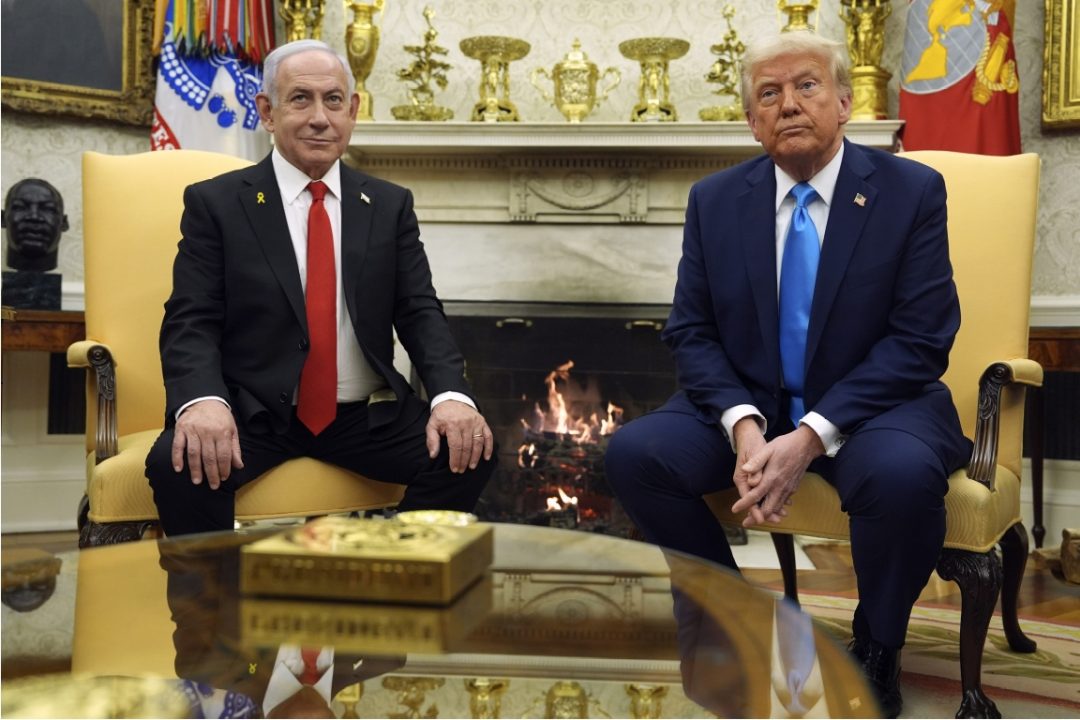
In a move that has sent shockwaves around the world, President Donald Trump announced plans for the United States to take control of the Gaza Strip and relocate its remaining Palestinian inhabitants to neighboring countries, a proposal widely condemned as a call for ethnic cleansing. The announcement has raised alarm over its legal, financial, and geopolitical consequences, representing a radical expansion of the burdens of American empire.
The Gaza Takeover Plan
On Tuesday, Israeli Prime Minister Benjamin Netanyahu visited Washington, D.C., where he met with President Trump to discuss the ongoing conflict in the Middle East. At a joint press conference, Trump stunned observers by unveiling an unprecedented plan: The United States would “take control” of and “own” Gaza. It will oversee its “leveling” and then reconstruction — after first removing its Palestinian population.
The announcement was not an off-the-cuff remark. Trump read the statement:
The U.S. will take control over the Gaza Strip, and we will do a job with it, too. We’ll own it and be responsible for dismantling all of the dangers of unexploded bombs and other weapons on the site, level the site and get rid of the destroyed buildings. Level it out, and create economic development that will supply unlimited numbers of jobs and housing for people in that area. Do a real job, do something different. Just can’t go back. If you go back, it’s gonna end up the same way it has for 100 years.
The announcement marks a sharp break from Trump’s earlier campaign messaging, which emphasized avoiding new foreign conflicts. Instead, this policy suggests a dramatic U.S. military and economic commitment, potentially entangling American forces in one of the world’s most volatile regions.
“Help” for Gaza: Forced Displacement
While the United States would “do the job” and rebuilt the place, remaining survivors of the enclave would have to move out of it.
When questioned about whether Palestinians would “have the right” to return to Gaza after its reconstruction, President Trump dismissed the possibility. He seemingly deflected: “Why would they want to return? That place has been hell…. Nobody could live there.”
One of the reporters is heard to interrupt Trump, “It’s their home, sir! Why would they leave?”
The president continued, suggesting that Palestinians from Gaza could relocate to Jordan, Egypt, and other unspecified countries. Trump claimed that “massive amounts of money” from “wealthy nations” would be used to fund their resettlement. He promised “quality housing” for Palestinians in up to six designated areas, away from their war-ravaged homeland.
Trump stressed that if they stay, Gazans would continue to “die,”
[You] could build something like a beautiful town, like some place where [Gazans] can live and not die. Because Gaza’s a guarantee that they gonna end up dying. That same thing is gonna happen again. It’s happened over and over again. And it’s gonna happen again as sure as you’re standing there.
Trump framed the plan as a generous act of “help.” He downplayed civilian deaths as mere instances of people “dying” rather than “being killed” or forced to flee. Prior to the outbreak of war in October 2023, the Gaza Strip had an estimated population of approximately 2.1 million people. During the press conference, Trump referred to “1.7 – 1.8 million” people.
Hellscape by Design
Last week, Trump called Gaza a “demolition site,” and rightfully so.
The enclave has experienced extensive destruction due to prolonged conflict. Recent analyses indicate that approximately 69 percent of Gaza’s buildings have sustained damage, with a significant number completely destroyed. Northern Gaza has been hit particularly hard. The most recent estimates suggest that between 70 and 80 percent of all buildings in the region have been damaged or demolished. The devastation encompasses residential areas, schools, hospitals, and essential infrastructure, rendering vast sections of the region uninhabitable.
This widespread destruction is the direct result of relentless Israeli airstrikes and ground operations made possible thanks to the United States.
Since October 7, 2024, the United States has provided Israel with more than $17.9 billion in military aid. The Biden administration, with approval of Congress, supplied Israel with precision-guided bombs, heavy artillery shells, and bunker-buster munitions. Those weapons have been instrumental in the large-scale pulverizing of Gaza’s infrastructure. The administration consistently framed these arms transfers as supporting Israel’s “limited” military operations against Hamas. Yet, the sheer scale of devastation has led to growing condemnation from numerous countries and international human rights groups. They argued that these weapons have been used to systematically level entire districts, exacerbating civilian suffering.
The destruction, paired with a massive civilian death toll, have been so extreme that South Africa filed a genocide case against Israel at the International Court of Justice (ICJ) in December 2023, accusing it of violating the 1948 Genocide Convention. The ICJ issued provisional measures in January 2024, ordering Israel to prevent genocide and allow humanitarian aid. Israel denied the charges, calling them “baseless.”
Price of “Owning” Gaza
Trump’s call for the United States to assume control of Gaza represents one of the most radical expansions of American military involvement in the Middle East in decades. The potential consequences include the following:
Prolonged Military Occupation: Securing and rebuilding Gaza would require an extensive U.S. military presence, possibly lasting years.
Financial Burden: Rebuilding Gaza into Trump’s envisioned “Middle Eastern Riviera” could cost tens of billions of dollars.
Diplomatic Fallout: The plan would alienate U.S. allies in Europe and the Arab world. They have increasingly criticized America’s unwavering support for Israel’s military operations.
Legal Violations: The forced displacement of Palestinians would put the U.S. in direct violation of international law, particularly Article 49 of the Geneva Conventions (ratified by U.S. Senate). That would lead to diplomatic isolation and legal challenges.
Increased Terrorism Risks: A U.S. occupation of Gaza could provoke retaliatory attacks from regional militant groups. That would increase threats to American personnel and interests worldwide.
The idea of the United States “owning” Gaza is not just reckless — it is a geopolitical catastrophe in the making. It would likely plunge America into another quagmire, mirroring the worst failures of past interventions, yet on an even greater scale. The financial, military, and moral costs of such an endeavor are staggering. Beyond that, it would erode what little credibility the United States still holds in the region.
Follow the Money?
As analysts scramble to make sense of Trump’s sudden urge to “own” Gaza and expel its people, one name keeps surfacing: AIPAC. The powerful pro-Israel lobby has long shaped U.S. foreign policy, and this latest move has some wondering just how much influence money can buy.
Since 2020, pro-Israel interest groups have poured more than $230 million into Trump’s political machine. Billionaire Miriam Adelson’s Preserve America PAC alone funneled $215 million, while the Republican Jewish Coalition, an AIPAC ally, chipped in another $14 million.
Of course, there’s no “direct” evidence that AIPAC’s deep pockets had anything to do with Trump’s Gaza plan — just an uncanny alignment of policy with the priorities of its biggest donors.
Business Opportunity
But the financial interests in Trump’s proposal don’t end there. In January, Trump described Gaza as “interesting,” calling it “a phenomenal location on the sea” with “the best weather.” Saying that it should be “rebuilt in a different way,” he added, “Some fantastic things could be done with Gaza.”
Trump’s remarks echoed those of his son-in-law and former senior advisor, Jared Kushner, who in February 2024 described Gaza as “valuable waterfront property.” Kushner suggested that under the right circumstances, it could become an economic hub. “I think from Israel’s perspective, I would do my best to move the people out and then clean it up,” he said.
With Trump and Kushner both deeply tied to real estate development, the so-called rebuilding effort raises questions about whether it is a business opportunity disguised as foreign policy.
Interestingly, this radical proposal was conspicuously absent from Trump’s campaign rhetoric. Perhaps this indicated a strategic decision to avoid alienating voters who might find such an idea unpalatable.




